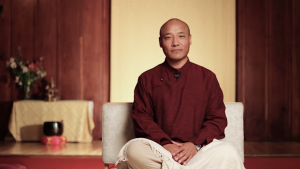In recent decades, the term “mindfulness” has become popular in both secular and spiritual communities. The practice, which began even before the time of the historical Buddha, has grown and changed in various ways as it has flowed into new lands and cultural settings. Today, we are the inheritors of numerous different and often conflicting meanings of the word “mindfulness”—so many that it becomes necessary to inquire more deeply whenever we encounter the term.
Mindfulness is defined as being aware of the present moment, while accepting reality without judgment. Thich Nhat Hanh (1926–2022), a well-known Vietnamese meditation master, coined the term mindfulness to describe positive energy that helps people recognize the happiness that already exists in their lives. Mindfulness is also defined as “bare attention” when alluding to its present-focused awareness. The mental, verbal, and physical aspects of mindfulness entail remembering the crucial action as well as cultivating enough heedfulness to forego needless action—bare attention. In a nutshell, mindfulness is a mental state of awareness-of-awareness, which means the mind is stable in its awareness.

Many people make the error of assuming that the concepts of mindfulness and concentration are interchangeable. In this context, Henepola Gunaratna (b. 1927), a Sri Lankan-born American meditation instructor, also known as Bhante G, clarified that mindfulness and concentration are two separate functions. “Mindfulness is a delicate function leading to refined sensibilities,” whereas “concentration could be defined as that faculty of the mind which focuses single-mindedly on one object without interruption,” Bhante G describes in his landmark book Mindfulness in Plain English (Buddhist Publications Society, 2011, 143–44).
South Asian mindfulness outside of Buddhism
Mindfulness practice is not a new trend initiated by modern people, but has been practiced by humans for thousands of years. Ancient people’s interest in meditation can be seen in artifacts from the Indus Valley or Harappa civilization (3300–1300 BCE). Many seals from the Indus Valley illustrate yogis or meditators in the lotus position. The allure of mindfulness practice to ancient people is revealed by archeological evidence of such artifacts.
Ancient literature from the Vedic period (1500–500 BCE), such as the Vedas, continued the mindfulness traditions by exposing integrated knowledge of meditation techniques prior to yoga practice. Yoga is a discipline that combines physical movement with mental healing and spiritual practice. Regardless, the Vedic word for “mindfulness” in Sanskrit was “smriti.” It is worth noting that Bengalis also pronounce mindfulness as “smriti,” which is derived from and thus similar to the Sanskrit term.

The Buddha’s development of the teaching of mindfulness
The practice of mindfulness advanced to a new level after the historical Buddha introduced the four foundations of mindfulness to his students, including mindfulness of the body, mind, feelings, and principles or phenomena. The Buddha clarified that a seeker’s practice of the four foundations of mindfulness would be developed while attempting to eliminate the five hindrances of sensual desire, ill-will, sloth and torpor, restlessness and worry, and doubt, as well as the advancement of seven awakening factors, namely, mindfulness, investigation, energy, joy, tranquility, insight, concentration, and equanimity.
The Buddha defined two meditation techniques: tranquility meditation and insight meditation. Tranquility meditation is widely regarded as a preliminary step to attaining mindfulness and instructs how to strengthen a calm state of mind. Insight meditation elevates the level of concentration and investigates mental phenomena in order to achieve sustained mindfulness.

Ancient Greek teachings on mindfulness
Europeans also recognized the mindfulness tradition, as documented by Roman Emperor Marcus Aurelius Antoninus’s (121–180 CE) reflectional writing Meditations. Marcus Aurelius focused on five major topics in his book: the impermanence or changing nature of a being, the truth of death and shortness of life, the role and relevance of a rational state of mind, dealing with others and how to overcome shortcomings, and the bliss of equanimity through refusing the desire for pleasure and reputation—as well as accepting conditions as they are.
Aurelius’s mindful reflections were specifically focused on the significance of awareness in comprehending the reality of nature, prior to ethical disciplines for attaining a peaceful life. Aurelius began his epic book by quoting the prominent Greek philosopher Plato (c. 424–c. 348 BCE). Prof. Gregory Hays at the University of Virginia, a translator of Meditations, believes that Aurelius’s thoughts were influenced not only by Plato’s philosophy but also by ancient Greco-Roman philosophers such as Aristotle (384–322 BCE), Socrates (470–399 BCE), Zeno (495–430 BCE), and Epicurus (341–270 BCE). From a Greco-Roman perspective, Marcus Aurelius’ approach set a standard template for mindfulness practice.

From ancient roots to modern practice
From the beginning of recorded history to the present day, mindfulness meditation has grown in popularity. We might now be living in what is sometimes referred to as the age of “McMindfulness.” Ronald E. Purser, a professor of management at San Francisco State University, wrote in his book McMindfulness: How Mindfulness Became The New Capitalist Spirituality (Repeater Books, 2019) that the term “McMindfulness” was coined by the Buddhist teacher and psychotherapist Miles Neale, who described “a feeding frenzy of spiritual practice that provides immediate nutrition but no long-term sustenance.”
Prof. Purser remarked that the present mindfulness craze is a business model comparable to McDonald’s. Just as the fast-food industry swiftly satisfies people’s hunger, mindfulness industries are rapidly expanding and fulfilling the expectations of modern seekers on a corporate level. A seeker in the age of McMindfulness aspires to acquire a mindful state as quickly as possible. Prof. Purser, recognizing the rise of a mindfulness industry, wrote:
Mindfulness is now said to be a $4 billion industry, propped up by media hype and slick marketing by the movement’s elites. More than 100,000 books for sale on Amazon have a variant of ‘mindfulness’ in their titles, touting the benefits of Mindful Parenting, Mindful Eating, Mindful Teaching, Mindful Therapy, Mindful Leadership, Mindful Finance, a Mindful Nation, and Mindful Dog Owners, to name just a few.
Prior to the widespread acceptance of mindfulness practice—and its commodification by the mindfulness industry—numerous meditation institutions that offered mindfulness instruction were established around the world. In the US, retreatants and practitioners register for meditation practice at places such as Spirit Rock Meditation Center, Zen Mountain Monastery, and Shambhala Mountain Center.
Following the trend of the global mindfulness revolution, Bangladesh also boasts a number of meditation facilities, in addition to the demand for mindfulness-based meditation in the Bengal Delta. The Quantum Method meditation center, which focuses on the science and meaning of life, is one of the most well-known institutes and teaches mindfulness in combination with spiritual and secular methods of meditation. Many Vipassana institutions based on Buddhist traditions can be found in Bangladesh. People who are worried, anxious, distracted, or in unstable mental states are offered the possibility of recovery through calming meditation (Samatha Bhavana) and insight meditation (Vipassana Bhavana) as found in most Buddhist monasteries.
Each year on 21 May, “World Meditation Day” is commemorated to recognize mindfulness practitioners, seekers, and retreatants from all over the world, with the intention of extending the light and positive vibes of present awareness from one person to the next, race to race, country to country, and community to community.


In conclusion, mindfulness is not only an urgent requisite for contemporary practitioners but has also been earnestly taken up and proclaimed by people throughout the history of humankind, from the East to the West. The practice of mindfulness has progressively been incorporated into people’s daily lives as they have come to recognize the value of emotional self-discipline, elevated concentration, and moral behavior. Concerns about corporatization aside, cultivating awareness through mindfulness practice remains an increasingly popular choice for both Buddhists and non-Buddhists around the world.
References
Anālayo, Bhikkhu. 2003. Satipaṭṭhāna: The Direct Path to Realization. Birmingham: Windhorse Publications.
Aurelius, Marcus. 2006. Meditations. Translated by Martin Hammond. London: Penguin Classics.
Barua, Benimadhab. 1921. A History of Pre-Buddhist Indian Philosophy. Calcutta: University of Calcutta.
Gunaratana, Mahāthera Henepola. 1981. The Satipaṭṭhāna Sutta and its Application to Modern Life. Kandy: Buddhist Publications Society.
———. 2011. Mindfulness in Plain English. New York: Wisdom Publications.
Hanh, Thich Nhah. 1987. The Miracle of Mindfulness: An Introduction to the Practice of Meditation. Translated by Mobi Ho. Boston: Beacon Press.
Mahajatok. 2021. Quantum Method. Dhaka: Seba Prakashani.
Purser, Ronald E. 2019. McMindfulness: How Mindfulness Became the New Capitalist Spirituality. London: Repeater Books.
Shaw, Sarah. 2006. Buddhist Meditation: An Anthology of Texts from the Pali Canon. London and New York: Routledge Taylor & Francis Group.
Related features from BDG
Mindfulness Made Real – A Review of Ratnadevi’s Bringing Mindfulness to Life
Mindfulness and Amida Buddha
Book Review: Mindfulness: Where it Comes From and What it Means
Guidelines for Authentic Mindful Technology
Leading with Wisdom in the Digital Age
















